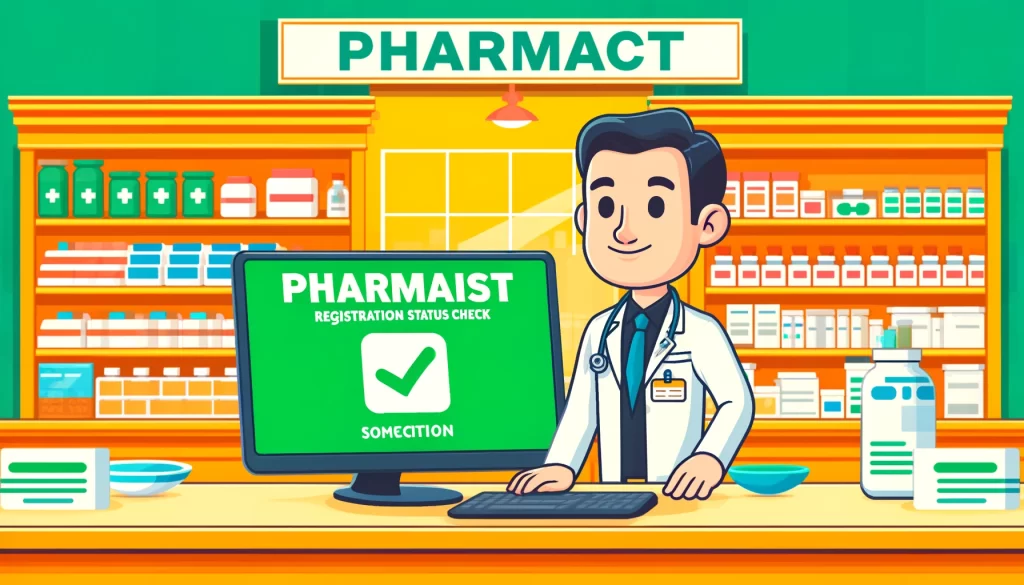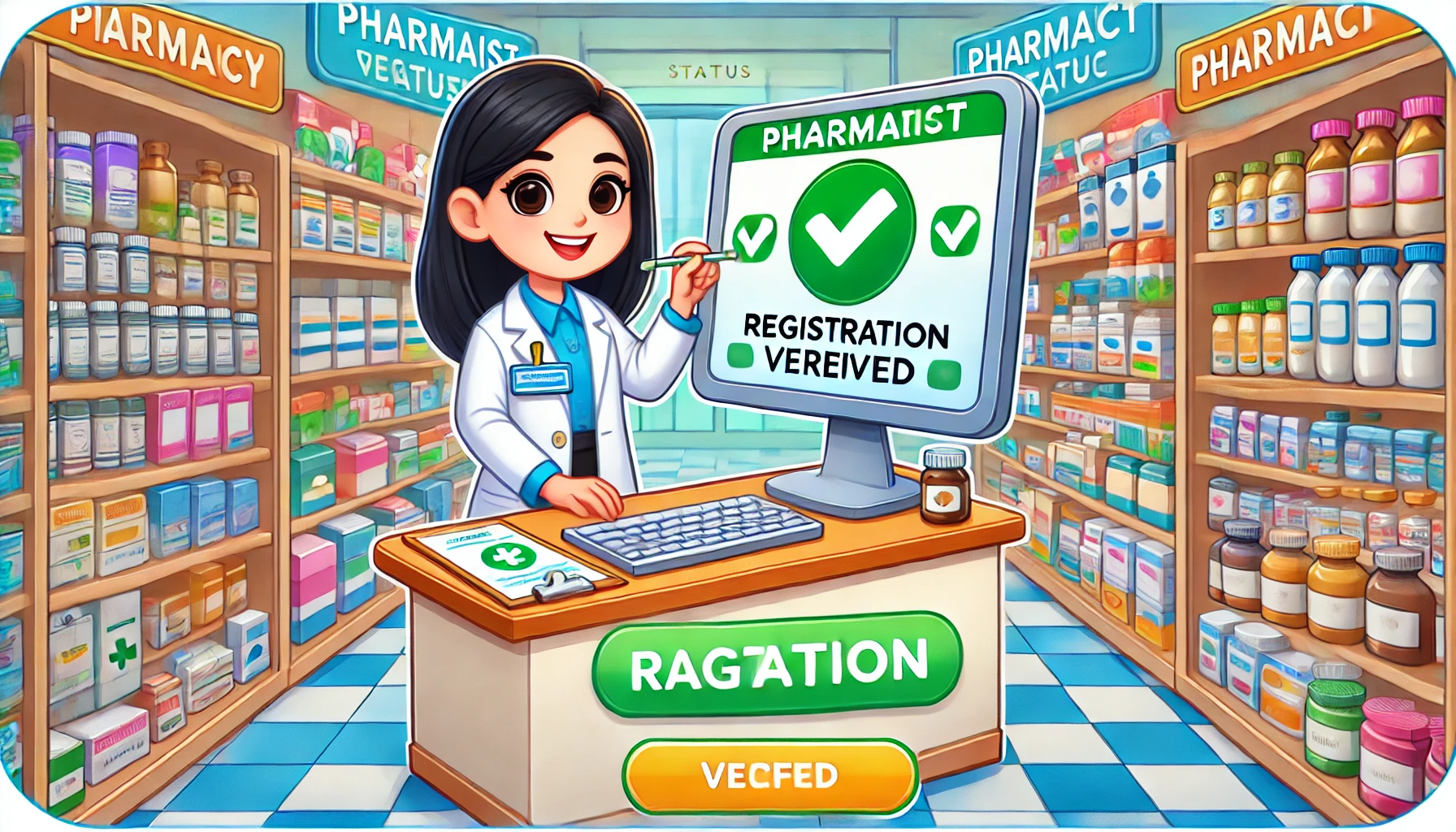The most important factor here is the patient’s health and welfare; it takes priority making sure a pharmacist is fully registered. These bodies also maintain a national register that the public can verify and validate registered pharmacists with any click. This validation is required to verify that the pharmacist is actually legitimately certified and able to handle legally, which guarantees trust/integrity (safety) of health care services. now you get information on Pharmacist Registration Status Check 2024 Check Online at pharmacy.delhi.gov.in by Registration Number.
Overview of Pharmacist Registration

| Aspect | Description |
|---|---|
| Purpose of Registration | To ensure that pharmacists meet the required professional standards for practicing pharmacy and dispensing medications. |
| Eligibility Requirements | Must hold a degree in pharmacy (e.g., Pharm.D., B.Pharm, M.Pharm) from an accredited institution. |
| Licensing Examinations | Includes passing comprehensive exams such as the NAPLEX and MPJE in the U.S., or equivalent exams in other countries. |
| Internship/Residency | Required completion of a practical training period under the supervision of a licensed pharmacist. |
| Continuing Education | Pharmacists must complete ongoing educational courses to maintain their registration and stay updated on new practices. |
| Registration Authority | Managed by national or regional pharmacy boards or councils, such as the Pharmacy Council of India or the State Boards in the U.S. |
| Registration Process | Involves submitting an application, required documents, and fees, followed by approval from the regulatory body. |
| Renewal Frequency | Typically annual or biennial, requiring proof of continuing education and a renewal fee. |
| Public Access to Information | Public can usually verify a pharmacist’s registration status through the regulatory body’s online portal. |
| International Practice | Pharmacists wishing to practice in different countries may need to meet additional requirements or undergo equivalence assessments. |
Registration as a pharmacist is an essential step that assures that the pharmacists possess all required competences to be able to practice safely. Typically done under the supervision of a regulatory body or pharmacy board, it is also regulated by these bodies to ensure that pharmacists possess the minimum specifications before they are permitted to practice. Pharmacists are licensed to dispense medications, counsel patients on appropriate drug use, and perform a number of other health care-related functions. Therefore, the registration should be updated, as well as any suggestions for further education to remain up-to-date in terms of new pharmaceutical knowledge and healthcare regulations. This is so pharmacists remain safe, effective practitioners and provide optimal care.
Importance of Registration in Pharmacy Practice
Registration in pharmacy practice serves as a crucial pillar ensuring the safety, integrity, and professionalism within the healthcare system. Here are the key reasons why registration is essential for pharmacists:
- Public Protection: The process of registration provides assurance that a pharmacist is adequately qualified and trained to dispense medications safely and provide healthcare advice. This helps prevent the possibility of malpractice by making sure pharmacists are competent enough to handle more intricate medical situations and drug interactions.
- Professionalism: Regulatory bodies ensure continued competency with a standard registration to practice threshold. This means all pharmacists, regardless of where they practice, will work to the same high standards of practice and conduct.
- Accountability: Registered pharmacists are responsible to a regulatory authority that takes disciplinary action in cases of the pharmacist engaging in professional misconduct. This accountability mechanism sustains trust in the pharmacy profession by ensuring that breaches of expected standards are dealt with fairly.
- Legal Permission to Practice: Registration grants pharmacists the legal right to dispense prescription medications, provide counseling, and perform health management duties. Pharmacists would not be legally allowed to practice as they have to be registered, and this is how the public is protected from harm by unqualified individuals.
- Professional Registration: Pharmacists with a valid license are held to the same standards of professionalism as those in direct patient care, including continuous professional development (e.g., the maintenance of knowledge and skills so that practitioners do not fall behind new developments in drug therapy and health care practice). Pharmacists too are continually required to keep themselves updated with the advances in medical practice and technology, which is absolutely essential for imparting quality health care services.
To sum up, the registration of pharmacists is an essential part of healthcare to ensure only qualified personnel deliver medicine and health advice. Maintains the professionalism of pharmacy, ensures patient safety, and helps in improving health standards.
Types of Exams Required
Pharmacists are required to pass specific examinations to become licensed and registered professionals. These exams are designed to assess the candidate’s knowledge, skills, and competencies necessary for safe and effective pharmacy practice. Here’s an overview of the common types of exams required for pharmacist registration:
- North American Pharmacist Licensure Examination (NAPLEX):
- Region: United States
- Purpose: To evaluate a candidate’s knowledge of drug therapy, disease state management, and safe and effective pharmacotherapy practices.
- Format: Computer-based test consisting of multiple-choice questions.
- Multistate Pharmacy Jurisprudence Examination (MPJE):
- Region: United States
- Purpose: To assess knowledge of pharmacy law as applicable in various states. Candidates usually take this exam in addition to the NAPLEX.
- Format: Computer-based test featuring questions on federal and state laws related to pharmacy.
- Pharmacy Examining Board of Canada (PEBC) Exams:
- Region: Canada
- Components:
- Qualifying Exam Part I (MCQ): A multiple-choice question exam that tests pharmaceutical, biological, and pharmacotherapeutic knowledge.
- Qualifying Exam Part II (OSCE): An Objective Structured Clinical Examination that assesses practical skills and problem-solving abilities in simulated environments.
- General Pharmaceutical Council (GPhC) Registration Assessment:
- Region: United Kingdom
- Purpose: To demonstrate that the candidate can apply knowledge effectively in practical situations.
- Format: Comprises two papers, one focusing on clinical pharmacy practice, pharmaceutical calculations, and the other on legislation, ethics, and professional practice.
- Australian Pharmacy Council (APC) Exams:
- Region: Australia
- Components:
- Knowledge Assessment of Pharmaceutical Sciences (KAPS): Assesses the pharmaceutical science knowledge necessary for practice in Australia.
- Intern Written Exam: Tests practical and clinical knowledge and problem-solving abilities.
- Pharmacy Board of India (PBI) License Examination:
- Region: India
- Purpose: To assess the candidate’s understanding of pharmaceutical sciences and ensure readiness for practice in the Indian context.
- Format: Varies by state, generally includes both written and oral examinations focusing on pharmacy practice, laws, and regulations.
These exams are essential for ensuring that pharmacists have the required competency to practice safely and effectively. The specific exams and their formats can vary depending on the country or region, but all aim to uphold high standards in the pharmacy profession.
Educational Requirements
All UK pharmacists must satisfy registration requirements set by the General Pharmaceutical Council (GPhC), which ensures they are appropriately qualified and competent. These requirements usually entail a mix of an undergraduate degree and professional education, including hands-on experience. Here’s a detailed overview:
1. Undergraduate Education
- Bachelor’s Degree: Typical for all new pharmaceutical graduates to get started with a Bachelor in pharmacy (B.Pharm), inspection, or connected discipline. It covers the fundamentals of chemistry, biology, and pharmacology.
- Pre-pharmacy courses: Some countries (including the United States) may allow a student to advance directly into a pharmD program following pre-pharmacy coursework in order to touch up on the necessary knowledge bases for an entry-level pharmD position. They teach human-based pharmacy courses like chemistry, biology, physiology, and anatomy, which help you enter the professional pharmacy program.
2. Professional Pharmacy Degree
- Doctor of Pharmacy (Pharm. D.): A professional degree for pharmacists in many countries, including the United States and Canada; idle (jQuery); The Pharm. Many optometry schools use the semester system, with a D. program that averages four years in length and includes classroom instruction as well as hands-on clinical experience.
- Master of Pharmacy (M.Pharm): A degree in pharmacy at Master’s level is also available after completion of a Bachelor degree, just like this course is offered in the UK and India with specialization options as clinical, pharmacist, and medicinal chemistry technologies.
3. Internship/Residency
- Practical training: Pharmacy students need to complete a certain number of hours under the supervision of a licensed pharmacist. The internship phase integrates the academic knowledge with practical skills.
- Residency: For pharmacists this is not a requirement, but if you want to delve into specific fields like hospital pharmacy, clinical pharmacy, or research for these specializations there is a residency program that runs for 1-2 years after your Pharm gang. D.
4. Licensure Examination
Licensure Exam as PArt of Educational Traectory, This is part of the educational trajectory for pharmacists to pass a national and/or state licensure exam, which will assess their competence to practice In the U.S., this includes taking and passing the North American Pharmacist Licensure Examination (NAPLEX) and, in most cases, a state-based jurisprudence examination, which signifies that an applicant is able to work as a clinical pharmacologist.
Required Documents
| Document | Description | Purpose |
|---|---|---|
| Proof of Identity | Government-issued ID (e.g., passport, driver’s license) | To verify the identity of the applicant. |
| Educational Certificates | Degrees and transcripts from educational institutions | To verify educational qualifications in pharmacy. |
| Proof of Internship/Residency | Certificates or letters from completed internships or residencies | To confirm practical training under supervised conditions. |
| Licensure Examination Results | Official scores from exams like NAPLEX, MPJE, or equivalent | To demonstrate passing of required licensure examinations. |
| Professional Photographs | Recent color photographs | Often required for the identification card or registration certificate. |
| Application Form | Completed registration application form | To provide personal and professional details for registration. |
| Criminal Background Check | Document indicating criminal history or a clean record | To ensure the applicant does not have disqualifying criminal offenses. |
| Proof of Legal Status (if applicable) | Visa, residency permit, or work permit documents | For non-citizens, to verify the legal right to work in the country. |
| Continuing Education Certificates | Documents proving completion of required continuing education courses | To verify ongoing professional development and learning. |
| Payment of Fees | Receipts for payment of application or registration fees | To confirm payment of necessary fees associated with the registration process. |
Check Pharmacist Registration Status Check 2024 Check Online at pharmacy.delhi.gov.in
To check the registration status of a pharmacist for the year 2024 online through the official website at pharmacy.delhi.gov.in, follow these steps:
- Open your web browser and go to the official website by typing pharmacy.delhi.gov.in in the address bar.
- On the homepage, look for the section or link labeled ‘Registration Status’ or similar.
- Click on the ‘Registration Status’ link, which will redirect you to the registration verification page.
- Enter the required details in the provided fields. This might include the pharmacist’s registration number, name, or other identifying information as specified on the page.
- Once you have entered the necessary information, click on the ‘Search’ or ‘Submit’ button to proceed.
- The website will display the registration status of the pharmacist. It will show whether the pharmacist is currently registered and the validity of their registration.
- If you need more detailed information or encounter any issues, the website may provide contact details of the regulatory authority or a help section for further assistance.
Ensure you have the correct details of the pharmacist, as incorrect information may lead to errors in retrieving the registration status.
Conclusion
When you do a pharmacist license verification, you are confirming if the pharmacist is currently registered with their college and consequently whether they meet all the regulatory requirements to practice in Canada. This, in turn, safeguards the safety and correctness of pharmaceutical services and helps to minimize costly consequences on public health by preventing an unqualified person from dispensing medication or advising people on healthcare.
Also Check
Pharmacist Registration Status Check Contact Details
| Contact Type | Details | Purpose |
|---|---|---|
| Official Website | pharmacy.delhi.gov.in | Primary source for online registration checks and information. |
| Customer Service Number | Example: +91 11 1234 5678 | For direct inquiries and support related to registration status. |
| Email Address | [email protected] | For detailed queries and to submit documents or applications. |
| Physical Address | Pharmacy Council, [Complete Address], Delhi, India | For postal correspondence or in-person visits. |
| Fax Number | Example: +91 11 8765 4321 | For sending documents that require physical verification. |
| Social Media | Links to social media pages (if available) | For updates, news, and informal queries. |

Vikas Gupta is an insightful content creator and financial analyst, educated in economics and public administration. At yojanastatuschecktoday.in, he specializes in simplifying complex government schemes, aiming to empower readers with vital information. His expertise helps citizens navigate and utilize government initiatives effectively, ensuring access to essential updates and developments.
